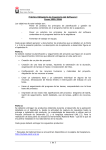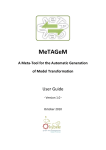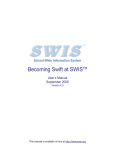Download MeTAGeM-Trace User Manual
Transcript
MeTAGeM-Trace User Manual Álvaro Jiménez, Juan M. Vara, Verónica A. Bollati and Esperanza Marcos Kybele Research Group, University Rey Juan Carlos, 28933 MADRID, Spain This manual shows how to use MeTAGeM-Trace to develop the Families2Persons1 transformation This scenario is used in order to avoid adding accidental complexity. A number of more complex scenarios (apart from the one used here) can be downloaded from the afore-mentioned Web site. 1. Set-up We are going to use the source files provided with the ATL Families2Persons basic example as source and target (meta)models. Therefore, following tasks must be completed before start the development of the transformation: 1. Download the source files of the ATL basic example2 to your local drive. Create a new project: File -> New -> General -> Project. 2. Import the project into your workspace: File -> Import -> Existing projects into workspace -> Select archive file (radio button) -> Finish. 3. Name the project as Families2persons. 2. Defining the MeTAGeM transformation model The process starts by defining a MeTAGeMDSL model that collects (at metamodel level) the relationships that must hold between source and target models. MeTAGeM-Trace provides a wizard to collect the data needed for the creation of such model: • File -> New -> Other -> MeTAGeM-Trace -> Metagem model. See Figure 1(a). • Next, you have to set the source and target metamodels of the transformation (recall that several source and target metamodels are allowed). • To that end, click the Add model button in order to give a (local) name and state which is the source file of each metamodel involved in the transformation. See Figure 1(b) and (c). 1 http://www.eclipse.org/m2m/atl/basicExamples Patterns/ 2 http://www.eclipse.org/m2m/atl/atlTransformations/Families2Persons/Families2Persons.zip Kybele Research Group October 31, 2012 • As a result, an empty Metagem model is created. See Figure 2. Figure 1: Metagem model creation wizard As shown in the figure, the model is automatically opened in a multi-panel editor that bundles three different panels to show separately the source models, the high-level transformation metamodel (Metagem model) and the target metamodels. If there are several source or target metamodels, they are be co-located vertically in their corresponding panel. Figure 2: Empty Metagem model Next, the different relationships between source and target metamodels have to be explicitly defined in the model. To that end, right-click on the root object of the (Metagem) model (Model root) -> New child -> Select the type of relationship to create (Figure 3). This time, we create a One-To-One relationship. Once the relationship object has been added, the source and target elements of such relationship has to be set. To that end, drag elements from source and target models and drop them on the transformation model. Note that the editor automatically limits the number of elements that can be referenced by a given relationship depending on the nature of the relationship. For instance, after 2 Figure 3: Adding relationship objects to Metagem model setting a source and target element in a One-To-One relationship, drag & drop functionality over such relationship object is automatically disabled. Back to the example, Figure 4 shows that the source element has already been set (Families!Father) whereas Persons!Person is been set as the target object for the One-To-One relationship previously added. Figure 4: Setting the target element of a One-To-One relationship Likewise, nested relationships can be defined in order to relate the properties of source and target classes. For instance, Figure 5 shows that the One-To-One relationship between Families!Male and Persons!Person contains another One-To-One relationship that binds their fistName and fullName properties Proceeding this way, the final Families2Persons Metagem model is shown in Figure 6. 3 Figure 5: Adding nested relationships to a Metagem model 3. Producing the Hybrid transformation model Next step of the process is to map the high-level specification of the transformation (Metagem transformation model) into a transformation model for the Hybrid approach: • Right-click on the Metagem model in the project explorer. • Run As -> MeTAGeM->Hybrid. See Figure 7(a). • Confirm or modify the suggested name and location for the Hybrid transformation model that will be produced. See Figure 7(b). Note that implicit model-checking is done before the MeTAGeM2Hybrid transformation is run. As a result, the Hybrid transformation model of Figure 8 is obtained. Every relationship defined in the Metagem model has given rise to, at least, a (Mapping) Rule object and a Trace Rule object in the Hybrid model. Nevertheless, some refinement is frequently needed in order to add imperative constructions to the transformation (recall that we target the Hybrid approach). This use to take the form of auxiliary functions used to return some value after perform some computation. For instance, shows the creation of the getFatherName() operation for Family!Father objects. • Right-click on the root element. • New Child -> Operation. See Figure 9(a). • Set the name, the return type and the context (object type for which the operation will work) of the operation. See Figure 9(b). 4 Figure 6: Complete Families2Persons Metagem model • You might set the body of the operation as well using the properties view. See Fig. 9(c). • Finally, if needed, arguments can also be defined. See Figure 9(d). Some bindings might need also refining. If the binding is immediate, e.g. a <- b there is no need to worry. It could be set directly in the Metagem model. However, if the binding is not immediate, i.e. some computation is needed before assigning the value, it has to be manually modeled in the Hybrid transformation model (note that this refinement could be delayed and done over the ATL or ETL model that will be later generated). Back to the example, the value of the Persons!Person.firstName property is returned by the getFatherName() operation previously defined. Therefore, it has to be explicitly modeled. This is shown in Figure10 • The Father 2 Male contains a binding object to set the value of the Person.firstName property. • Hence, the LeftPattern of such binding points to the Person.firstName property. • What rests is to set the RightPattern of the binding to point to the getFatherName() operation. • This way, once the transformation is run, the value returned by the operation will be assigned to the property. 5 Figure 7: Running the MeTAGeM2Hybrid transformation Another type of binding that needs refinement is the one that entails two or more source elements. Note that a binding is always related to just one target element since it is defined to set the value for such object. However, several source objects might be needed to compute such value. For instance, let suppose that we are not using an operation to get the value for the Persons!Person.fullName property. • Such value is obtained from concatenating the value of the Families!Member.firstName property and the Families!Member.lastName property. • Therefore, the binding object that sets the value for the Persons!Person.fullName property has to reference the two mentioned source properties. • The belongsTo reference of the objects representing such properties in the transformation model has to be manually set to the corresponding objects. • The result is shown in Figure 11 It is worth noting that the belongsTo reference is automatically resolved when the binding references to just one source object, . As shown before, the Hybrid transformation model considers the modeling of two types of traceability relationships. TraceRule objects represent traces that will be derived from the execution of a mapping rule (a kind of top-level trace) whereas TraceBinding objects represent the traces that will be generated by the execution of a binding. These objects are automatically generated from the Metagem transformation model. However, the user may be interested in defining new traceability relationships. To that end, you should proceed as follows. 6 Figure 8: Families2Persons Hybrid transformation model • First of all, a new Rule object has to be added since the existing ones were produced by the Metagem2Hybrid transformation. So they already contain a TraceRule object and the tool does not allow to create more TraceRule objects inside them. Note that this is the right behavior since traces can be n-ary. • Right-click on the root element -> New Child -> Rule. See Figure 12(a). • Set the source and target elements of the rule (e.g. Families!Member and Persons!Person). See Figure 12(b). • Right-click on the root element -> New Child -> TraceRule. See Figure 12(c). • Optionally, set the name of the TraceRule object. Note that the tool set automatically its source and target elements by looking at the containing Rule. See Figure 12(e). TraceBinding objects are created similarly. The main difference is that the user must specify to which binding does the TraceBinding belong to since a rule usually contains several bindings. 4. Producing the ATL/ETL transformation model Next step of the MDD development of model transformations supported by MeTAGeM-Trace consists of mapping the Hybrid transformation model into an 7 Figure 9: Adding getFatherName() operation to the Hybrid transformation model ATL or ETL transformation model, depending on the targeted language. To that end, MeTAGeM-Trace bundles a pair of launchers • Right-click on the Hybrid transformation model and select the targeted language. See 13. • Confirm or modify the suggested name and location for the ATL/ETL transformation model that will be produced. • The corresponding ATL or ETL transformation model is automatically obtained. See 13 a) and b) respectively. • As it happened with the Metagem2Hibrid transformation, model checking is implicitly invoked before the selected transformation (either Hybrid2ATL or Hybrid2ETL) is executed. 5. Generating the source-code Last step of the process is to obtain the source-code that implements the modeled transformation. To that end, MeTAGeM-Trace we should proceed as with the previous automated steps: • Right-click on the ATL/ETL transformation model. • Select the targeted language, either ATL or ETL (see Figure 14): – Extract ATL model to ATL file (MeTAGeM-Trace). 8 Figure 10: Setting the RightPattern of a binding to the value returned by the getFatherName() operation Figure 11: Refining multiple source bindings: setting the value of the belongsTo reference – Extract ETL model to ETL file (MeTAGeM-Trace). Note that the source-code generated will probably need from manual refinement. As mentioned before, code for model navigation is usually needed, as well as some re-naming of variables. Nevertheless, we have empirically assessed that more than 80% of the source-code of the transformation is generated by MeTAGeM-Trace, improving drastically development times. In this sense, it is wirth noting that MeTAGeM-Trace is oriented to help model transformation developers, i.e. it is not a tool intended for novice developers although we have discovered that it contributes to reduce the learning curve of model transformation development. 6. Generating trace models Recall that apart from providing a tool to develop model transformations, the main advantage of MeTAGeM-Trace is that produced transformations are be able to generate, not only the corresponding target models, but also a trace 9 Figure 12: Creating a TraceRule object Figure 13: Running the (a)Hybrid2ATL and (b)Hybrid2ETL transformations model. Therefore, the last section of this manual is devoted to show such functionality in action by running the Families2Persons transformation. Note that running the transformation is an issue related with the corresponding targeted language. You can look the corresponding manual for more information on how to run ATL and ETL transformations. The only difference is that the transformation will produce an “extra” model in this case . • Right-click over the source file of the transformation (either ATL or ETL, though we will focus on the ATL one here). • Run-as -> Run configurations • Select the source, target and trace models metamodels. See Figure 15: note that the Traces metamodel is already available in the EMF registry. 10 Figure 14: Generating ATL(a) or ETL(b) source-code • Run the transformation using the above-described configuration. As a result, apart from the target model, a trace model like the one shown in 16 is generated. If you open the model with the multi-panel editor bundled in MeTAGeM-Trace you will notice that: • When a trace-link object is selected in the trace model, corresponding source and target objects are automatically highlighted in the left and right panel. For instance, the picture shows that the Mother 2 Female trace link has been selected. Consequently, the source and target objects referenced by such trace (Marge and MargeSimpson) are automatically highlighted. automatically highlighted in the corresponding models. • Likewise, if a source or target object is selected in the left or right panel, the trace links referencing it are automatically highlighted in the central panel. 11 Figure 15: Running the ATL transformation Figure 16: Families2Persons trace model 12



















